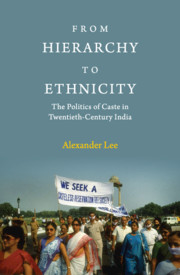Book contents
- Frontmatter
- Dedication
- Contents
- List of Tables
- List of Figures
- Acknowledgements
- 1 Introduction
- 2 Explaining Identity Activism
- 3 Caste in Historical Context
- 4 Caste in the Census of India
- 5 The Causes of Ranked Rhetoric
- 6 Caste since Independence
- 7 Conclusion
- Appendix A Data
- Appendix B Statisical Tests
- Appendix C Additional Tables and Figures
- Bibliography
- Index
1 - Introduction
Published online by Cambridge University Press: 14 January 2020
- Frontmatter
- Dedication
- Contents
- List of Tables
- List of Figures
- Acknowledgements
- 1 Introduction
- 2 Explaining Identity Activism
- 3 Caste in Historical Context
- 4 Caste in the Census of India
- 5 The Causes of Ranked Rhetoric
- 6 Caste since Independence
- 7 Conclusion
- Appendix A Data
- Appendix B Statisical Tests
- Appendix C Additional Tables and Figures
- Bibliography
- Index
Summary
One caste, two strategies
In the year 1880, Samuel Sargunar, a deputy registrar in the revenue department of Chingleput district in the far south of India, published a small pamphlet entitled Dravida Kshatriyas. The book is concerned with the social status of the Shanans, a Tamil caste (or jati) traditionally associated with the disreputable occupation of palm liquor production, but many of whose members had recently become prosperous through their involvement in trade or (as in Sargunar's case) the colonial bureaucracy.
Sargunar's argument was that a terrible historical mistake had occurred: the Shanans, instead of being liquor traders, were really kings and warriors, the ancient rulers of all of south India, and had gained their current bad reputation due to a revolt of the ‘servants’ against their natural Shanan masters (Hardgrave 1969: 81–84). The natural solution was for the Shanans to reclaim their former status by readopting the habits of high caste Hindus.
Over the next three decades, wealthy Shanans enthusiastically took Sargunar's advice. A series of books and genealogies ‘proved’ that the word ‘Shanan’ was a Tamil synonym for king (Hardgrave 1969: 82–87). Shanans petitioned the colonial census authorities three times to allow members of the group to be recorded as Kshatriyas, and when their petitions were refused many still managed to do so, despite warnings that this would depress the numbers of their own group and raise the numbers of the upper castes (Francis 1902; Molony 1912; Boag 1922). Some Shanans began to wear the sacred thread (the traditional symbol of Hindu orthodoxy), hire Brahmin priests to perform their ceremonies, practise vegetarianism, discourage widow remarriage, and even tie their dhotis and wear their hair in the upper caste fashion (Hardgrave 1969: 112). Shanan weddings became lavish displays of self-assertion, costing thousands of rupees, with the grooms carried on palanquins by other castes, a traditional mark of kingship. At the same time, the wealthy reformers were at pains to de-emphasize their links to those Shanans who remained involved in palm liquor production. Not only did wealthy urban Shanans cease marrying and dining with poorer ones but they also created a system of kangaroo courts to punish with beatings those found to be selling liquor (Hardgrave 1969: 106, 137).
- Type
- Chapter
- Information
- From Hierarchy to EthnicityThe Politics of Caste in Twentieth-Century India, pp. 1 - 28Publisher: Cambridge University PressPrint publication year: 2020



